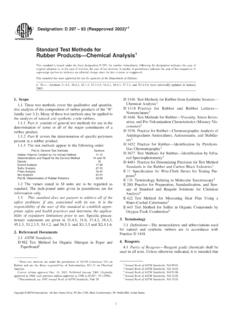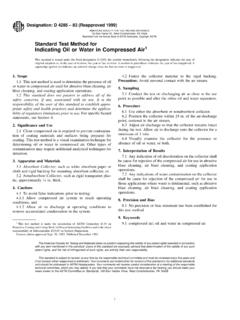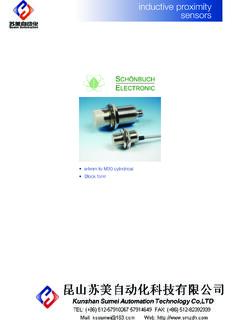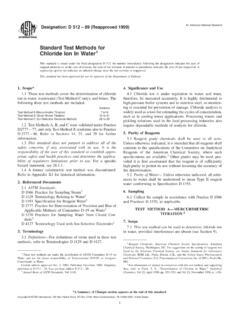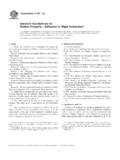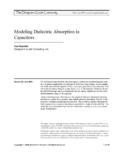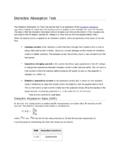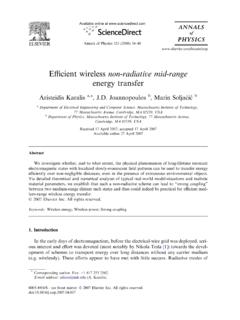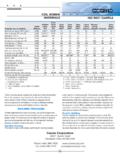Transcription of Standard Test Method for Water Absorption of …
1 Designation: D 570 98. Standard Test Method for Water Absorption of Plastics1. This Standard is issued under the fixed designation D 570; the number immediately following the designation indicates the year of original adoption or, in the case of revision, the year of last revision. A number in parentheses indicates the year of last reapproval. A. superscript epsilon (e) indicates an editorial change since the last revision or reapproval. 1. Scope Comparison of Water Absorption values of various plas- This test Method covers the determination of the relative tics can be made on the basis of values obtained in accordance rate of Absorption of Water by plastics when immersed. This with and test Method is intended to apply to the testing of all types of Ideal diffusion of liquids4 into polymers is a function of plastics, including cast, hot-molded, and cold-molded resinous the square root of immersion time.
2 Time to saturation is products, and both homogeneous and laminated plastics in rod strongly dependent on specimen thickness. For example, Table and tube form and in sheets mm ( in.) or greater in 1 shows the time to approximate time saturation for various thickness. thickness of nylon-6. The values given in SI units are to be regarded as the The moisture content of a plastic is very intimately Standard . The values stated in parentheses are for information related to such properties as electrical insulation resistance, only. dielectric losses, mechanical strength, appearance, and dimen- This Standard does not purport to address all of the sions. The effect upon these properties of change in moisture safety concerns, if any, associated with its use. It is the content due to Water Absorption depends largely on the type of responsibility of the user of this Standard to establish appro- exposure (by immersion in Water or by exposure to high priate safety and health practices and determine the applica- humidity), shape of the part, and inherent properties of the bility of regulatory limitations prior to use.
3 Plastic. With nonhomogeneous materials, such as laminated forms, the rate of Water Absorption may be widely different NOTE 1 ISO 62 is technically equivalent to this test Method . through each edge and surface. Even for otherwise homoge- 2. Referenced Documents neous materials, it may be slightly greater through cut edges than through molded surfaces. Consequently, attempts to ASTM Standards: correlate Water Absorption with the surface area must generally D 647 Practice for Design of Molds for Test Specimens of be limited to closely related materials and to similarly shaped Plastic Molding Materials2 specimens: For materials of widely varying density, relation ISO Standard : between Water - Absorption values on a volume as well as a ISO 62 Plastics Determination of Water Absorption3 weight basis may need to be considered. 3. Significance and Use 4. Apparatus This test Method for rate of Water Absorption has two Balance An analytical balance capable of reading chief functions: first, as a guide to the proportion of Water g.
4 Absorbed by a material and consequently, in those cases where Oven, capable of maintaining uniform temperatures of the relationships between moisture and electrical or mechanical 50 6 3 C (122 6 F) and of 105 to 110 C (221 to 230 F). properties, dimensions, or appearance have been determined, as a guide to the effects of exposure to Water or humid 5. Test Specimen conditions on such properties; and second, as a control test on The test specimen for molded plastics shall be in the the uniformity of a product. This second function is particu- form of a disk mm (2 in.) in diameter and mm (1 8 in.). larly applicable to sheet, rod, and tube arms when the test is in thickness (see Note 2). Permissible variations in thickness made on the finished product. are mm ( in.) for hot-molded and mm ( in.) for cold-molded or cast materials. 1. This test Method is under the jurisdiction of ASTM Committee D-20 on Plastics and is the direct responsibility of Subcommittee D on Permanence Properties.
5 4. Current edition approved July 10, 1998. Published January 1999. Originally Additional information regarding diffusion of liquids in polymers can be found published as D 570 40 T. Last previous edition D 570 95. in the following references: (1) Diffusion, Mass Transfer in Fluid Systems, E. L. 2. Discontinued 1994; replaced by D 1896, D 3419, D 3641, D 4703, and D 5227. Cussler, Cambridge University Press, 1985, ISBN 0-521-29846-6, (2) Diffusion in See 1994 Annual Book of ASTM Standards, Vol Polymers, J. Crank and G. S. Park, Academic Press, 1968, and (3) Permeation, 3. Available from American National Standards Institute, 11 W. 42nd St., 13th Diffusion, and Sorption of Gases and Vapors, R. M. Felder and G. S. Huvard, in Floor, New York, NY 10036. methods of Experimental Physics, Vol 16C, 1980, Academic Press. Copyright ASTM International, 100 Barr Harbor Drive, PO Box C700, West Conshohocken, PA 19428-2959, United States.
6 1. D 570. TABLE 1 Time to Saturation for Various Thickness of Nylon-6 Specimens of materials whose Water - Absorption value Thickness, mm Typical Time to 95 % Saturation, h would be appreciably affected by temperatures in the neigh- 1 100 borhood of 110 C (230 F), shall be dried in an oven for 24 h 2 400 at 50 6 3 C (122 6 F), cooled in a desiccator, and imme- 1 000. 10 10 000. diately weighed to the nearest g. 25 62 000. NOTE 4 If a static charge interferes with the weighing, lightly rub the surface of the specimens with a grounded conductor. Specimens of materials, such as phenolic laminated NOTE 2 The disk mold prescribed in the Molds for Disk Test plastics and other products whose Water - Absorption value has Specimens Section of Practice D 647 is suitable for molding disk test been shown not to be appreciably affected by temperatures up specimens of thermosetting materials but not thermoplastic materials.
7 To 110 C (230 F), shall be dried in an oven for 1 h at 105 to ISO Standard Specimen The test specimen for homo- 110 C (221 to 230 F). geneous plastics shall be 60 by 60 by 1 mm. Tolerance for the When data for comparison with Absorption values for 60-mm dimension is 62 mm and mm for the 1-mm other plastics are desired, the specimens shall be dried in an thickness. This test Method and ISO 62 are technically equiva- oven for 24 h at 50 6 3 C (122 6 F), cooled in a desic- lent when the test specimen described in is used. cator, and immediately weighed to the nearest g. The test specimen for sheets shall be in the form of a bar mm (3 in.) long by mm (1 in.) wide by the thickness 7. Procedure of the material. When comparison of Absorption values with Twenty-Four Hour Immersion The conditioned speci- molded plastics is desired, specimens mm (1 8 in.) thick mens shall be placed in a container of distilled Water main- should be used.
8 Permissible variations in thickness shall be tained at a temperature of 23 6 1 C ( 6 F), and shall mm ( in.) except for asbestos-fabric-base phenolic rest on edge and be entirely immersed. At the end of 24, +1 2, laminated materials or other materials which have greater 0 h, the specimens shall be removed from the Water one at a Standard commercial tolerances. time, all surface Water wiped off with a dry cloth, and weighed The test specimen for rods shall be mm (1 in.) long to the nearest g immediately. If the specimen is 1 16 in. or for rods mm in diameter or under and mm (1 2 in.) less in thickness, it shall be put in a weighing bottle immedi- long for larger-diameter rods. The diameter of the specimen ately after wiping and weighed in the bottle. shall be the diameter of the finished rod. Two-Hour Immersion For all thicknesses of materials The test specimen for tubes less than 76 mm (3 in.)
9 In having a relatively high rate of Absorption , and for thin inside diameter shall be the full section of the tube and specimens of other materials which may show a significant mm (1 in.) long. For tubes 76 mm (3 in.) or more in inside weight increase in 2 h, the specimens shall be tested as diameter, a rectangular specimen shall be cut 76 mm in length described in except that the time of immersion shall be in the circumferential direction of the tube and mm in reduced to 120 6 4 min. width lengthwise of the tube. Repeated Immersion A specimen may be weighed to The test specimens for sheets, rods, and tubes shall be the nearest g after 2-h immersion, replaced in the Water , machined, sawed, or sheared from the sample so as to have and weighed again after 24 h. smooth edges free from cracks. The cut edges shall be made smooth by finishing with No.
10 0 or finer sandpaper or emery NOTE 5 In using this test Method the amount of Water absorbed in 24. h may be less than it would have been had the immersion not been cloth. Sawing, machining, and sandpapering operations shall interrupted. be slow enough so that the material is not heated appreciably. Long-Term Immersion To determine the total Water NOTE 3 If there is any oil on the surface of the specimen when received or as a result of machining operations, wash the specimen with absorbed when substantially saturated, the conditioned speci- a cloth wet with gasoline to remove oil, wipe with a dry cloth, and allow mens shall be tested as described in except that at the end to stand in air for 2 h to permit evaporation of the gasoline. If gasoline of 24 h they shall be removed from the Water , wiped free of attacks the plastic, use some suitable solvent or detergent that will surface moisture with a dry cloth, weighed to the nearest evaporate within the 2-h period.



